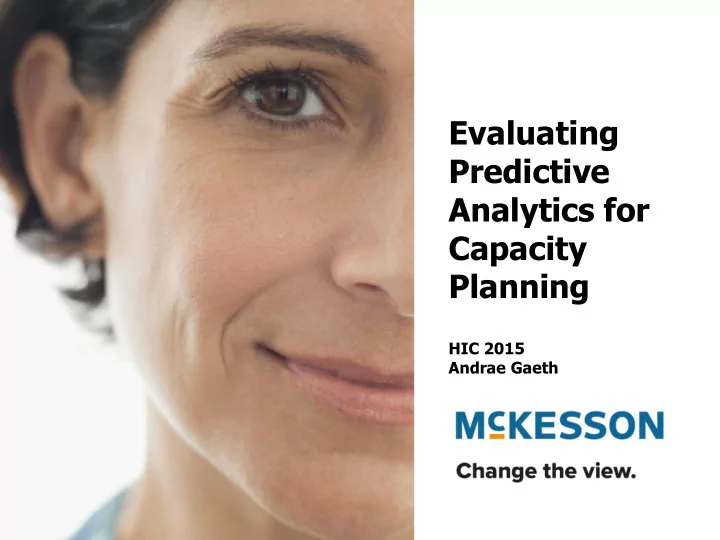

Evaluating Predictive Analytics for Capacity Planning HIC 2015 Andrae Gaeth
What is predictive analytics? Predictive analytics is the practice of extracting information from existing data sets, and then applying various techniques (eg, statistical, modelling) in order to determine patterns and predict future outcomes and trends. How can we practically evaluate and use predictive analytics solutions for capacity planning within health?
Paradigm Shift Required for Analytics Maturity What should I do? Prescriptive What will happen? Predictive What is happening? Real Time Why did it happen? Descriptive What happened? Descriptive Sources: Competing on Analytics , Tom Davenport Gartner IT Glossary
What to look for with Capacity Planning 1. Manages multiple planning horizons – Multi-year, annual, 6-8 week scheduling periods, weeks, days and hours 2. Continuously updates forecasts 3. Forecasts patient demand with consistently high absolute accuracy vs. stated accuracy % aggregated over time 4. Forecasts volumes for door-to-door patient flow vs. preset intervals and departments 5. Converts forecasts automatically into capacity and staffing needs 6. Supports user insight, input and adjustment as part of the planning process
Strategic & Annual Planning • Discuss “what - if” options, regional plan • Budget and physical capacity decisions • Set targets and assumption (linking plans) Monthly & Weekly Planning • Manage “current” variation to plan • Update forecasts & roster staff • Informed decision making Daily Planning • Unit focus: manage current & projected pts. • Focus on relieving immediate flow issues • Replace sick leave? Book casual
Forecasting Methods Used for Operational Planning Predictive modeling Algorithmic modeling Pattern identification Scenario modeling Simulation Optimization
Predictive Determining, mathematically, the relationship between the explanatory variables and the predicted variable, based on historical data Examples: Insurance: relationship between certain characteristics of a person and lifestyle and predicted outcome of a certain claim Capacity Planning: relationship between status of ED at a given time of day and the impact on Inpatient beds tomorrow
Pattern Identification ‘Time series forecasting’ identifies different patterns within the predicted variable itself, such as trend, seasonality and day of the week. Various combinations of those patterns can then be used to derive a forecast
Algorithmic Take recent averages and distributions of past activity for certain locations, services and day of the week or special event days. Then apply an algorithm to utilize these to create a projection
Scenario Allow users to input their own assumptions or ‘what ifs’ into the prediction to assess impacts (vs. based purely on patterns of past activity) Annual Census Annual Patients In Annual Patient Turn 2012 2014 2012 2013 2014 2013 2012 2013 2014 Hospital Total 145,201 150,721 151,870 25,756 28,384 30,308 5.6 5.3 5.0 Emergency 122,548 130,929 133,984 20,201 23,016 25,266 6.1 5.7 5.3 Scheduled 22,653 19,792 17,887 5,555 5,368 5,042 4.1 3.7 3.5 ICU 4,229 4,984 5,546 560 764 787 7.6 6.5 7.0 Emergency 4,113 4,509 5,304 543 727 756 7.6 6.2 7.0 Scheduled 115 475 242 17 37 31 6.8 12.8 7.8 Cardiac ICU 2,732 2,764 2,536 1,125 1,156 1,170 2.4 2.4 2.2 Emergency 1,510 1,630 1,506 511 615 606 3.0 ALOS 12% 2.6 2.5 Activity 16% Bed days 4% Scheduled 1,222 1,134 1,030 614 541 564 2.0 2.1 1.8 IP Cardiac 14,197 14,147 14,058 3,270 3,488 3,554 4.3 4.1 4.0 Emergency 9,128 10,111 10,041 1,968 2,314 2,354 4.6 4.4 4.3 Scheduled 5,068 4,036 4,017 1,302 1,174 1,200 3.9 3.4 3.3 IP Surgery 43,161 43,830 41,924 6,675 6,800 6,943 6.5 6.4 6.0 Emergency 31,140 33,538 32,961 4,265 4,549 4,884 7.3 7.4 6.7 • Analyze which services were driving these trends? Scheduled 12,021 10,292 8,963 2,410 2,251 2,059 5.0 4.6 4.4 • What do we expect this year? Sustain or continue trends? • What change initiatives are we investing in to increase volumes and reduce ALOS?
Simulation Coded logic which emulates the actual individual patient ADT activity of planned patient admissions/bookings
Optimisation Using either a mathematical or algorithmic approach to derive the optimal outcome, based on an ‘objective function’. ‘Business as usual’ would have required 50 – 60 beds staffed; using an optimised activity plan resulted in 40 - 50 04/04/2013 04/08/2013 04/12/2013 04/16/2013 04/20/2013 04/24/2013 04/28/2013 05/02/2013 05/06/2013 05/10/2013 05/14/2013 05/18/2013 05/22/2013 05/26/2013 05/30/2013 06/03/2013 06/07/2013 06/11/2013 06/15/2013 06/19/2013 06/23/2013
Combining Approaches Historical Data Develops base patient demand based on current trends seen from historical data. Pathways Algorithms Patient pathways leveraged to Algorithms applied to forecast simulate and/or optimise any increasing accuracy of patient impact on OR’s and inpatient units. demand. Clinical Input Customers clinical expert input of areas that may impact any patient demand added.
Comparing Planning Approaches Aggregate vs. Patient-level Static vs. Dynamic Short term vs multi-horizon Top down vs. Bottom up
Recommend
More recommend